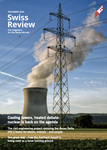The solitary winters in the Jura contributed to the development of the clock- and watch-making industry. Today, Switzerland’s culture of mechanical precision is promoting the cutting-edge technology of professional drones, robots capable of inspecting tanks, providing emergency aid and flying for months on end in the stratosphere.
These sophisticated drones, equipped with micro-technology and intended for export, occupy niche markets, in contrast to recreational flying robots, which are primarily used for capturing images and mass produced especially by the Chinese firm DJI. This is true of Flyability – a spin-off from the intelligent systems laboratory (LIS) of the EPFL (Federal Institute of Technology Lausanne), which has developed a drone designed to “tolerate collisions with obstacles in its way”, says Marc Gandillon, head of marketing.
Surveillance of sensitive areas
Encased by a pliant and lightweight armour, Elios is the flagship product of this company based in Frenchspeaking Switzerland, which has a 30-strong workforce. It is capable of penetrating damaged buildings in the search for victims by smashing into walls or carrying out industrial inspection tasks. The company sold a hundred units in 2016, at a cost of 25,000 Swiss francs each. Flyability has a turnover of two million Swiss francs, and is planning a 200 % increase in its workforce in 2017. There is a virtuous chain in this small market. The development of Flyability, for example, is benefiting Pix4D, another spin-off of the EPFL which produces the 3D mapping software installed in Elios.
senseFly, the pioneer in professional drone technology in Switzerland – and a company that emerged from LIS but is now owned by the French firm Parrot – is like a grandfather figure in this market. EBee, its V-shaped flying robot, focuses on land surveillance. “Over the long-term, Swiss farmers will use drones to monitor the development of crops, and drone technology will be deployed in a wide range of professional fields, such as the surveillance of sensitive areas,” predicts Marc Gandillon of Flyability.
In German-speaking Switzerland, the Federal Institute of Technology also acts as an incubator for start-ups. One example is Fotoskype, which emerged from the Flying Machine Arena laboratory. It has developed a flying drone equipped with a safety leash. Zurich is also home to Verity Studios whose miniature drones have been used in a Broadway show produced by Cirque du Soleil. Its founder, Raffaello D’Andrea, jointly set up Kiva, a drone company acquired by Amazon in 2012.
Towards versatile robots
Flying in the lower part of uncontrolled air space – i.e. below 150 metres – drones are utilising a relatively unexploited natural space set aside for rescue helicopter operations, for example. Their ability to adapt to different spaces and terrains has improved over the years. The engineer Stefano Mintchev heads up a team of five undergraduates and postgraduates at the EPFL. These mechanical and aerospace specialists are working on “versatile” drones capable of changing shape depending upon their environment. To enable rescue operations to be carried out, one project is focusing on flying robots which can approach victims. Another prototype is equipped with “artificial feathers and retractable wings to fly in strong winds and perform manoeuvres between buildings”. Simon Johnson, the co-founder and CEO of OpenStratosphere, explains: “Drones contain lots of moving parts. They require lightweight and reliable electronics. Switzerland’s high-precision industry meets these requirements.”
Doctor Mintchev’s team is also working on pliable drones, which can be deployed in otherwise inaccessible areas. Another idea is drones capable of attaching themselves to walls or ceilings to save energy. “In terms of innovation for flying robots, Switzerland is probably amongst the leading players worldwide,” the researcher says. The positive role played by the Federal Office of Civil Aviation (FOCA) in this development deserved praise, Mintchev said, “because the issue of flight regulations is a stumbling block for drones”.
Benoit Curdy, head of the international professional association Global UTM (for the management of unpiloted air traffic), based in Lausanne, believes that the FOCA exercises a type of diplomacy regarding drones. “This office sends representatives to international expert groups. They are listened to and that has a positive impact on Swiss industry,” he adds. One such example is a flight concept developed by the FOCA which defines the flight authorisation procedures for drones by adapting them to the context, “by differentiating, for example, between a private flight in a garden and flying over urban areas in which regulations are tight”, says Benoit Curdy.
Stéphane Herzog is an editor with “swiss review”
An alliance between research and marketing
Switzerland’s success in the field of flying robots is owed to the National Centre of Competence in Research (NCCR) Robotics, an organisational structure which forges links between Switzerland’s leading laboratories. Led by a pioneering figure in this field, Dario Floreano, the head of the intelligent systems laboratory at the EPFL, this foundation brings together primarily the two Swiss federal institutes of technology. It has received support for 12 years from the Swiss National Science Foundation. “Dario Floreano coordinates the efforts of NCCR members and ensures they do not overlap,” explains Simon Johnson, the co-founder and CEO of OpenStratosphere (see opposite). “Through the success of the Vaud-based spin-offs in particular, the foundation has shown there is a market for these drones. This technology transfer is now set to increase. If we succeed in occupying a global niche that will open up lucrative prospects.” Revenues in the market could reach 1 billion Swiss francs within a year or two, according to the international professional association Global UTM.
Swiss drones in the stratosphere providing “neutral” services
Hiring out fleets of “low-altitude regional satellites” (effectively drones) to governments to perform land surveillance, communication and geo-localisation services is the plan of Simon Johnson, head of OpenStratosphere, a company that has emerged at the EPFL. These ultra-light drones with huge wings will fly at an altitude of 10 to 50 km, where the air is rarefied but the wind and solar conditions are ideal, reveals the specialist. “We’re going to utilise a virgin space currently devoid of infrastructure. It will be cheaper to fly there without a pilot because safety costs are very high at that altitude. The satellite drones will fly at a speed of 100 kilometres an hour for a period of six months thanks to batteries recharged by solar panels,” says Johnson. These machines will operate at a lower altitude than satellites – which do not orbit below 200 km (at a speed of 28,000 km/h) – but higher than aeroplanes, which do not generally exceed an altitude of 14 km. All of this comes at a lower cost, and another benefit is that these flights are controlled by governments.
The commercial use of observation and communication systems is strategic by definition. “We currently control our roads and dams but, as far as space is concerned, we depend on countries with satellites, and on the US in particular, which has the GPS system. This type of drone, tested by Airbus in particular, will enable the service to become regional, and it will be authorised in the stratosphere over countries,” Simon Johnson believes. In light of this, he is convinced that “Switzerland, as a neutral country, is very well positioned to play a pioneering role in this near space industry.”
Picture Many Swiss companies are manufacturing professional drones, such as Flyability, shown here with a drone at the Swiss Robotics Industry Day 2016. Photo: Keystone











Comments
Comments :
Ein weiteres waere die Identifizierung und Zuweisung von Drohnen, Besteuerung uvm